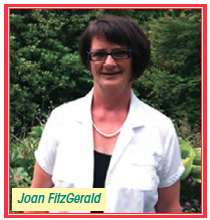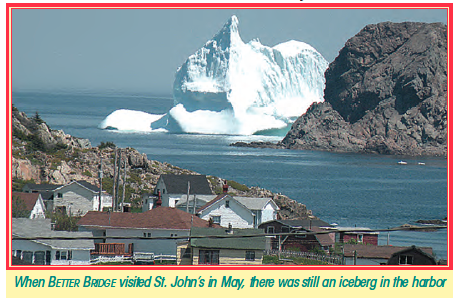
Joan FitzGerald lives in St. John’s. She had been an accountant all her adult life, and if anyone had told her five years ago that she would own a bridge club and be teaching bridge, she would have told them, “Not possible.”
“I knew teaching would be an important part of the club, but I had no idea about teaching bridge; I’d tutored my peers in grade 7 and 8 math! But where would I start?”
Start she did. Now Joan is the owner of Bridge on the Edge, a thriving bridge club with enthusiastic regular players enjoying what she created. “As long as the players support the club, I’ll do my best for them. I feel I cannot let the players down.”
It began in 2010. Joan took teacher training courses and the director’s course approved by the American Contract Bridge League. Then she worked with her friend Richard and, on August 26th, 2011, they opened their first sanctioned game in St. Mark’s Church Hall on Logy Bay Road.
Bridge seminars that focus on sharing information about how to set up a club list locations that might be suitable. And churches across the continent host bridge games. So it’s not surprising that the club started in a church. It worked well until it was Fall Fair time. Then the church needed the space back. So a few months later the club was without a site. Richard was a member of the Bill Rahal Ball Club. They had a clubhouse that was vacant during the winter months, so Bridge on the Edge duplicate games and lessons went to the ball club.

“We spent a lovely winter there before the ball club took back the venue in May 2012. Spring had arrived and the ball players needed their clubhouse, of course. Also Richard had other work so we parted ways.”
“I actually considered closing the club, but players were booked for the next couple of games and lessons, so I moved the bridge club to my home for the summer months while I looked for a new location.”
“By September 2012 I’d negotiated with, and booked, the Elks’ Club on Carpasian Road. It’s almost two years later, and we’re still very happy in our new home.”
“Bridge on the Edge is a privately owned club, but I continue to tell the players that this is their club. Without them it couldn’t exist.”

Easy words to say, but it’s true. She allows the players to take part in the club. For example, every Thursday Barb Baldwin, known as ‘Resident Baker,’ brings cakes, cookies, tea, buns, or some other home-made treats for all the players.
“Every now and then I’ll see players arrive with a bag of flour or sugar or chocolate chips or some other baking item for Barb. This past week, two players brought a Thank You card and had everyone sign it. They provided an envelope for donations to help with the expense of providing these treats every week.”
The club also has a resident poet, Father John Maddigan. Joan shared one of his poems.
Players tend to come early each day and help with the room set up, putting out the Bidding Boxes.
“At the end of the game when I turn around, everything has been picked up and put away. Everyone is wonderful”
Joan has a unique blend of skills. She’s highly organized, inventive, capable—yet she’s spontaneous and flexible. The members don’t have to sign up to a schedule that outlines when they will contribute; under her leadership it just happens.
The club is on the cutting edge of what’s going on in the bridge world in North America. For instance they use Bridgemates electronic scoring.
Potential challenges are anticipated before they become problems. For example, slow play can be difficult to manage. At tournaments, there are hospitality breaks which work well to handle those participants not playing in a timely fashion. Bridge on the Edge has a clock that was programmed by Rich Waugh from Florida. It can be set to automatically time the rounds. It sits on Joan’s computer and is turned toward the game. It can be set to have a five-minute break at the end of each hour. “The players rave about this feature,” Joan says.

The Common Game is another bridge initiative. It comes out of Florida and has been popularized by Jay Whipple and his daughter Sarah. Over a hundred bridge clubs are part of it, and Bridge on the Edge is one of them.
The Common Game provides deal records to the clubs before a game. The deals have been analyzed by professional bridge players. Clubs with dealing machines can have their machine deal out the hands in ‘cloaked’ mode so that they are not displayed as they are dealt. Then, even the director doesn’t see the deals ahead of time. Players can compare scores with players outside their club. It enhances the playing experience.
There are many special events: all players are offered a free game or lesson on the week of their birthday. If the club is not open in that week, a free game is offered at the member's next chance to play. The second Thursday of the month, there’s a mentoring program where the less experienced players have an opportunity to playwith more experienced players. The players love ‘pot luck’ suppers, and Joan negotiated with the Elks’ Club so they’re allowed to have these events.
All details are seamlessly handled. New cards, comfortable chairs, clean tables, delicious coffee. There’s no doubt. Bridge on the Edge is on the cutting edge.